This 7-night Safari in Botswana Is All About Wildlife, Water, and Sustainability — Here's What It Was Like to Visit
The Okavango Delta creates a safari landscape like no other.
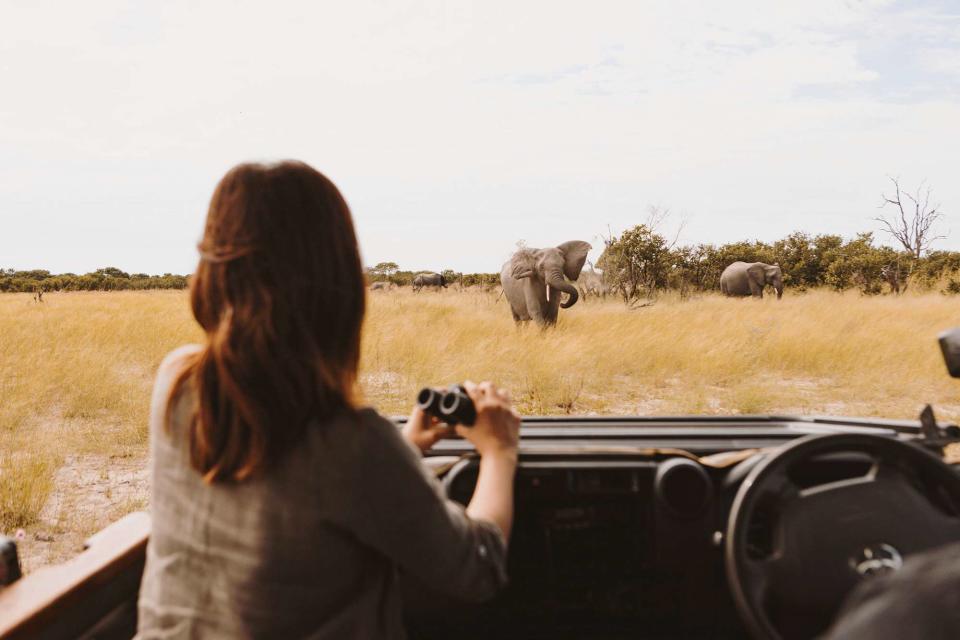
Courtesy of Wilderness Safaris
Less than an hour after landing at a remote airstrip, we're having sundowners en route to the lodge. A troop of dozens — perhaps a hundred — baboons returns to the trees around us to roost for the night. A nosy kudu slowly circles our makeshift camp. Chatty squirrels chitter away in the branches above our heads. We sip our gin and tonics and watch as the Okavango Delta settles into dusk. So it goes on safari in Botswana.
We hop back into the jeep and make for Vumbura Plains, our home for the next few nights, passing elephants under trees and lechwe antelope spread across the flooded plains. But interestingly, it's not the wildlife that captivates me on the ride. It's the water.
The Okavango Delta is a sprawling inland delta, and each winter, floodwaters from the Okavango River inundate some three million acres of grassland and desert. It creates a vast waterscape that not only draws human visitors like me but plenty of animal ones, too. So as we're driving to the lodge, my heart stops as the road disappears into the waters — and I hold my breath as we plunge right in. "You might want to pick up that bag," our Wilderness guide Dave Luck says to me as the water gurgles beneath the floor of the jeep, seeping in through the crevices.
The floodwaters aren't very deep, though, and the local guides know where the roads twist and turn, even if I can't see anything through the murk. It's a surreal feeling to be navigating these waters in a jeep rather than on a boat.
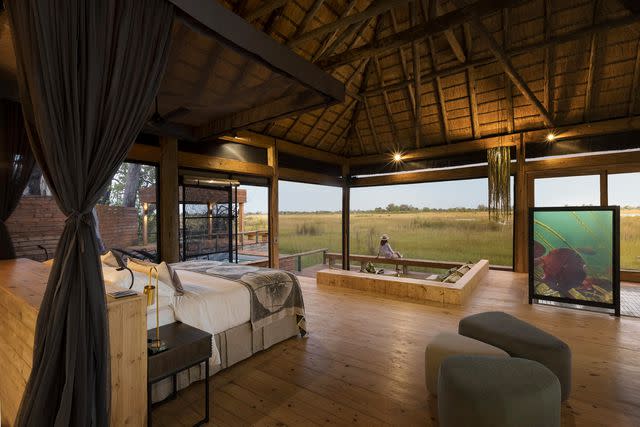
Courtesy of Wilderness Safaris
We arrive at Vumbura Plains, and there's plenty more water to be found here. The camp was newly rebuilt in 2022 and now has a series of 14 open-air suites connected by elevated wooden walkways. I sit in my sunken living room adorned with water-lily motifs, and even though it's after dark, I can hear wildlife wading through the water all around me.
The water remains a source of intrigue for me during our stay at Vumbura Plains, perhaps even more so as we take to the skies in a helicopter. From our aerial vantage point, I can see just how expansive the floodwaters are — and how filled they are with wildlife. Water-loving hippos and crocodiles are spread across the saturated plains, while elephants march single-file through the reeds, creating meandering pathways visible from the air.
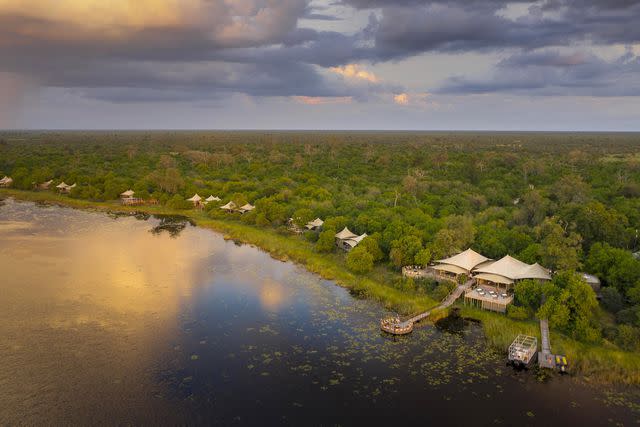
Courtesy of Wilderness Safaris
Our next adventure takes us away from the floods, in the Linyanti Concession, where the eight-room DumaTau camp becomes our next home. There is water here, too, as the lodge sits on a riverfront that's very popular with elephants. In fact, one waltzes right past my tented suite as I'm reclining for an afternoon nap.
On one of our game drives across the dry terrain, we see dozens of vultures perched on every tree within eyesight. And that means one thing: dinner is served. (Not ours, of course, but lions'.)
As we make our way through the tall, rustling grass, we spot a few lounging lionesses and their playful cubs. Then the smell hits us: it's a slightly putrid buffalo, one that the lions have been feasting on for some time. One lioness is polishing off its exposed ribs, her strong teeth tearing into the flesh and peeling it straight off the bone. Dave hands me a small tin filled with a fragrant salve. "For the smell," he notes, rubbing some under his nose. The trick works wonders, and we continue our observations of the feast.
You might think such a sight (and odor) might deter us from our own dinner back at DumaTau, but the cuisine at this camp is too delectable to pass up. The food system, as the printed menu tells me, is responsible for some 30 percent of global greenhouse gas emissions. So Wilderness designs "mindful menus" here, incorporating locally sourced, sustainable ingredients into its dishes to reduce its "foodprint." What's more, food waste is minimized by the kitchen's upcycling team, which turns scraps into preserves, pickles, and stocks. Nothing goes to waste in nature, and so it shall be at Wilderness camps, too.
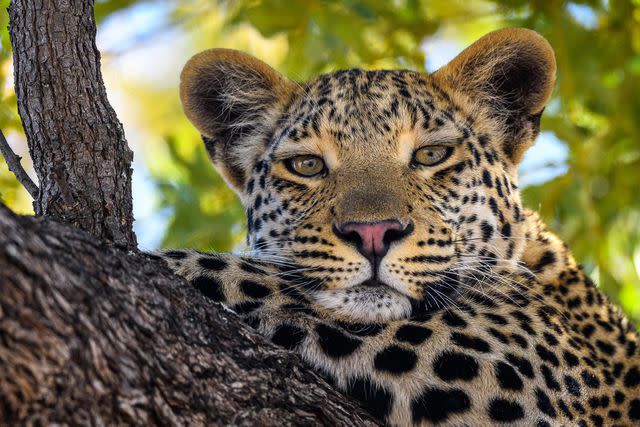
Courtesy of Wilderness Safaris
Our final leg of the safari takes us back to the Okavango Delta, this time to the camp Jao. And here, I'm awestruck at the architecture. Jao feels like a movie set. It's a series of striking, modern tree houses that blend natural elements with high design and sustainable engineering. (The thatch, for instance, is actually made from recycled plastic.)
The room that really takes my breath away is the double-height library and wine room, at the center of which is a giraffe skeleton. Jao is equal parts futuristic and classic safari, and it's certainly a feast for the eyes.
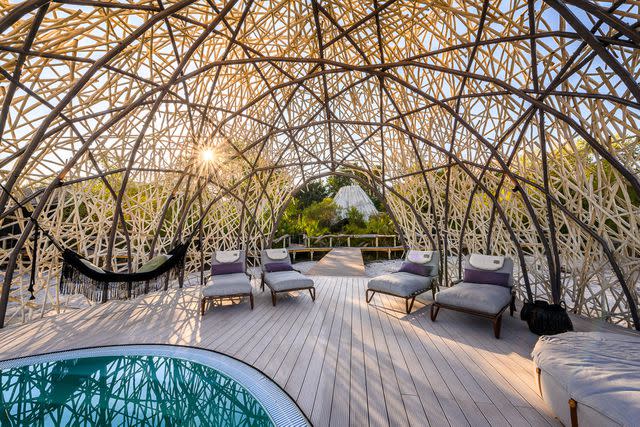
Courtesy of Wilderness Safaris
We return to watery adventures in the delta, but not in jeeps. One afternoon, we take a more traditional form of transportation: a hand-carved mokoro canoe. Skilled gondoliers use long poles to propel us through the floodwaters, pausing at points to teach us about the flora of the region. We make necklaces out of water lilies and wear them proudly as we glide through the reeds.
On our last night in Botswana, the staff prepares us a beautiful sundowner send-off — a massive spread arranged on my suite's terrace surrounding a fire pit. As we watch the light fade over the water, we once more sip on our gin and tonics, the sights and sounds of our trip shining brightly in our memories.
A seven-night, three-camp Bucket List Botswana safari with Wilderness starts at $12,120 per person; book your trip at wildernessdestinations.com.
For more Travel & Leisure news, make sure to sign up for our newsletter!
Read the original article on Travel & Leisure.

